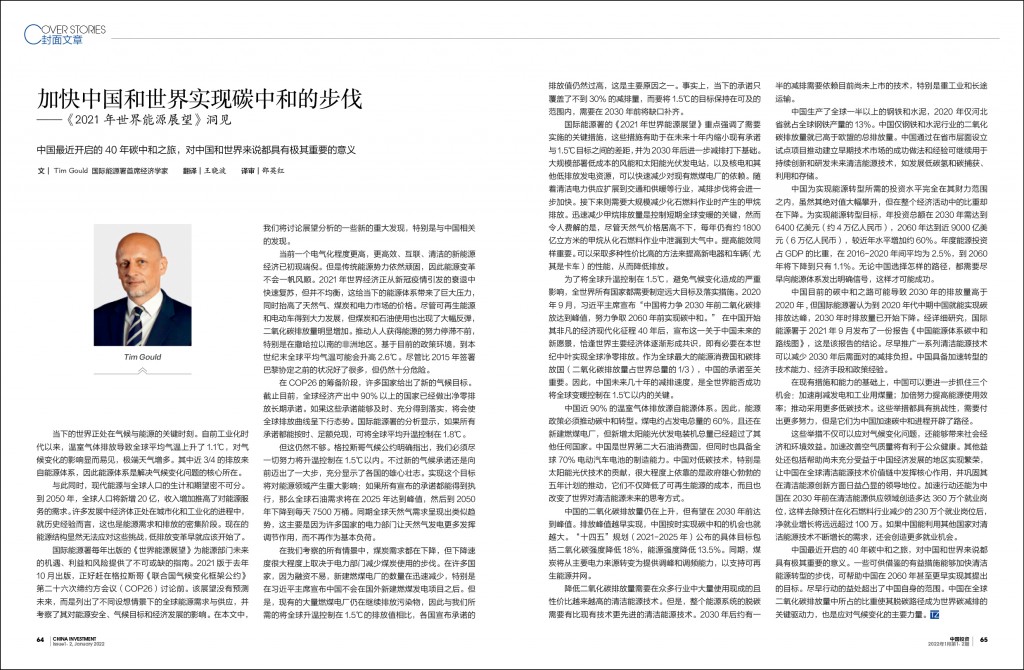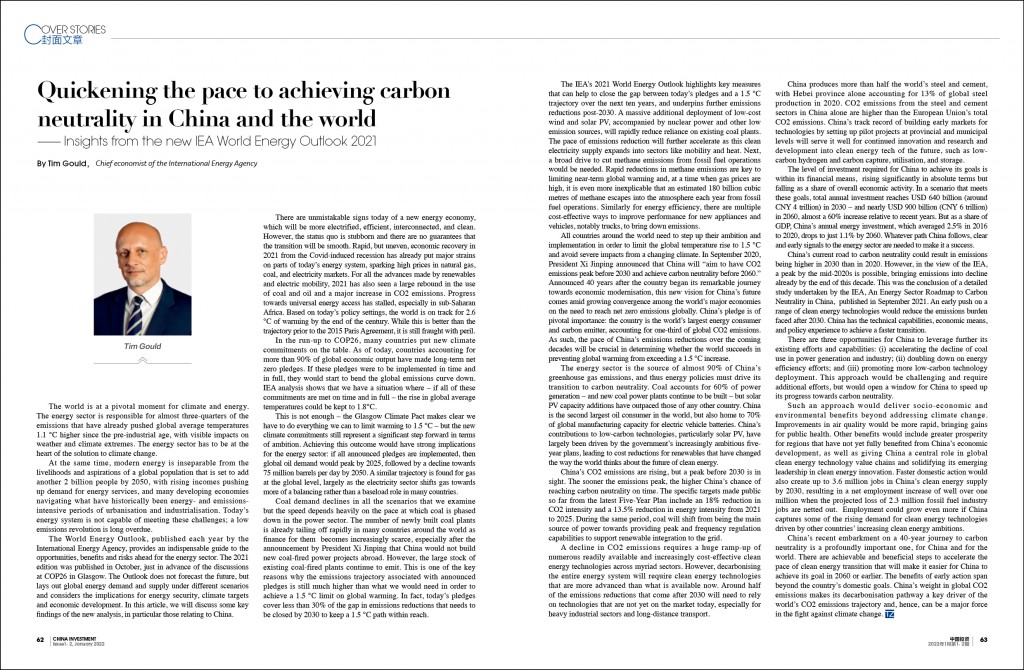
1月封面文章
2022展望
By Tim Gould, Chief economist of the International Energy Agency
文|Tim Gould 国际能源署首席经济学家
导读
Quickening the pace to achieving carbon neutrality in China and the world
—— Insights from the new IEA World Energy Outlook 2021
The world is at a pivotal moment for climate and energy. The energy sector is responsible for almost three-quarters of the emissions that have already pushed global average temperatures 1.1 °C higher since the pre-industrial age, with visible impacts on weather and climate extremes. The energy sector has to be at the heart of the solution to climate change.
At the same time, modern energy is inseparable from the livelihoods and aspirations of a global population that is set to add another 2 billion people by 2050, with rising incomes pushing up demand for energy services, and many developing economies navigating what have historically been energy- and emissions-intensive periods of urbanisation and industrialisation. Today’s energy system is not capable of meeting these challenges; a low emissions revolution is long overdue.
The World Energy Outlook, published each year by the International Energy Agency, provides an indispensable guide to the opportunities, benefits and risks ahead for the energy sector. The 2021 edition was published in October, just in advance of the discussions at COP26 in Glasgow. The Outlook does not forecast the future, but lays out global energy demand and supply under different scenarios and considers the implications for energy security, climate targets and economic development. In this article, we will discuss some key findings of the new analysis, in particular those relating to China.
There are unmistakable signs today of a new energy economy, which will be more electrified, efficient, interconnected, and clean. However, the status quo is stubborn and there are no guarantees that the transition will be smooth. Rapid, but uneven, economic recovery in 2021 from the Covid-induced recession has already put major strains on parts of today’s energy system, sparking high prices in natural gas, coal, and electricity markets. For all the advances made by renewables and electric mobility, 2021 has also seen a large rebound in the use of coal and oil and a major increase in CO2 emissions. Progress towards universal energy access has stalled, especially in sub-Saharan Africa. Based on today’s policy settings, the world is on track for 2.6 °C of warming by the end of the century. While this is better than the trajectory prior to the 2015 Paris Agreement, it is still fraught with peril.
In the run-up to COP26, many countries put new climate commitments on the table. As of today, countries accounting for more than 90% of global economic output have made long-term net zero pledges. If these pledges were to be implemented in time and in full, they would start to bend the global emissions curve down. IEA analysis shows that we have a situation where – if all of these commitments are met on time and in full – the rise in global average temperatures could be kept to 1.8°C.
This is not enough – the Glasgow Climate Pact makes clear we have to do everything we can to limit warming to 1.5 °C – but the new climate commitments still represent a significant step forward in terms of ambition. Achieving this outcome would have strong implications for the energy sector: if all announced pledges are implemented, then global oil demand would peak by 2025, followed by a decline towards 75 million barrels per day by 2050. A similar trajectory is found for gas at the global level, largely as the electricity sector shifts gas towards more of a balancing rather than a baseload role in many countries.
Coal demand declines in all the scenarios that we examine but the speed depends heavily on the pace at which coal is phased down in the power sector. The number of newly built coal plants is already tailing off rapidly in many countries around the world as finance for them becomes increasingly scarce, especially after the announcement by President Xi Jinping that China would not build new coal-fired power projects abroad. However, the large stock of existing coal-fired plants continue to emit. This is one of the key reasons why the emissions trajectory associated with announced pledges is still much higher than what we would need in order to achieve a 1.5 °C limit on global warming. In fact, today’s pledges cover less than 30% of the gap in emissions reductions that needs to be closed by 2030 to keep a 1.5 °C path within reach.
The IEA’s 2021 World Energy Outlook highlights key measures that can help to close the gap between today’s pledges and a 1.5 °C trajectory over the next ten years, and underpins further emissions reductions post-2030. A massive additional deployment of low-cost wind and solar PV, accompanied by nuclear power and other low emission sources, will rapidly reduce reliance on existing coal plants. The pace of emissions reduction will further accelerate as this clean electricity supply expands into sectors like mobility and heat. Next, a broad drive to cut methane emissions from fossil fuel operations would be needed. Rapid reductions in methane emissions are key to limiting near-term global warming and, at a time when gas prices are high, it is even more inexplicable that an estimated 180 billion cubic metres of methane escapes into the atmosphere each year from fossil fuel operations. Similarly for energy efficiency, there are multiple cost-effective ways to improve performance for new appliances and vehicles, notably trucks, to bring down emissions.
All countries around the world need to step up their ambition and implementation in order to limit the global temperature rise to 1.5 °C and avoid severe impacts from a changing climate. In September 2020, President Xi Jinping announced that China will “aim to have CO2 emissions peak before 2030 and achieve carbon neutrality before 2060.” Announced 40 years after the country began its remarkable journey towards economic modernisation, this new vision for China’s future comes amid growing convergence among the world’s major economies on the need to reach net zero emissions globally. China’s pledge is of pivotal importance: the country is the world’s largest energy consumer and carbon emitter, accounting for one-third of global CO2 emissions. As such, the pace of China’s emissions reductions over the coming decades will be crucial in determining whether the world succeeds in preventing global warming from exceeding a 1.5 °C increase.
The energy sector is the source of almost 90% of China’s greenhouse gas emissions, and thus energy policies must drive its transition to carbon neutrality. Coal accounts for 60% of power generation – and new coal power plants continue to be built – but solar PV capacity additions have outpaced those of any other country. China is the second largest oil consumer in the world, but also home to 70% of global manufacturing capacity for electric vehicle batteries. China’s contributions to low-carbon technologies, particularly solar PV, have largely been driven by the government’s increasingly ambitious five-year plans, leading to cost reductions for renewables that have changed the way the world thinks about the future of clean energy.
China’s CO2 emissions are rising, but a peak before 2030 is in sight. The sooner the emissions peak, the higher China’s chance of reaching carbon neutrality on time. The specific targets made public so far from the latest Five-Year Plan include an 18% reduction in CO2 intensity and a 13.5% reduction in energy intensity from 2021 to 2025. During the same period, coal will shift from being the main source of power towards providing peak and frequency regulation capabilities to support renewable integration to the grid.
A decline in CO2 emissions requires a huge ramp-up of numerous readily available and increasingly cost-effective clean energy technologies across myriad sectors. However, decarbonising the entire energy system will require clean energy technologies that are more advanced than what is available now. Around half of the emissions reductions that come after 2030 will need to rely on technologies that are not yet on the market today, especially for heavy industrial sectors and long-distance transport.
China produces more than half the world’s steel and cement, with Hebei province alone accounting for 13% of global steel production in 2020. CO2 emissions from the steel and cement sectors in China alone are higher than the European Union’s total CO2 emissions. China’s track record of building early markets for technologies by setting up pilot projects at provincial and municipal levels will serve it well for continued innovation and research and development into clean energy tech of the future, such as low-carbon hydrogen and carbon capture, utilisation, and storage.
The level of investment required for China to achieve its goals is within its financial means, rising significantly in absolute terms but falling as a share of overall economic activity. In a scenario that meets these goals, total annual investment reaches USD 640 billion (around CNY 4 trillion) in 2030 – and nearly USD 900 billion (CNY 6 trillion) in 2060, almost a 60% increase relative to recent years. But as a share of GDP, China’s annual energy investment, which averaged 2.5% in 2016 to 2020, drops to just 1.1% by 2060. Whatever path China follows, clear and early signals to the energy sector are needed to make it a success.
China’s current road to carbon neutrality could result in emissions being higher in 2030 than in 2020. However, in the view of the IEA, a peak by the mid-2020s is possible, bringing emissions into decline already by the end of this decade. This was the conclusion of a detailed study undertaken by the IEA, An Energy Sector Roadmap to Carbon Neutrality in China, published in September 2021. An early push on a range of clean energy technologies would reduce the emissions burden faced after 2030. China has the technical capabilities, economic means, and policy experience to achieve a faster transition.
There are three opportunities for China to leverage further its existing efforts and capabilities: (i) accelerating the decline of coal use in power generation and industry; (ii) doubling down on energy efficiency efforts; and (iii) promoting more low-carbon technology deployment. This approach would be challenging and require additional efforts, but would open a window for China to speed up its progress towards carbon neutrality.
Such an approach would deliver socio-economic and environmental benefits beyond addressing climate change. Improvements in air quality would be more rapid, bringing gains for public health. Other benefits would include greater prosperity for regions that have not yet fully benefited from China’s economic development, as well as giving China a central role in global clean energy technology value chains and solidifying its emerging leadership in clean energy innovation. Faster domestic action would also create up to 3.6 million jobs in China’s clean energy supply by 2030, resulting in a net employment increase of well over one million when the projected loss of 2.3 million fossil fuel industry jobs are netted out. Employment could grow even more if China captures some of the rising demand for clean energy technologies driven by other countries’ increasing clean energy ambitions.
China’s recent embarkment on a 40-year journey to carbon neutrality is a profoundly important one, for China and for the world. There are achievable and beneficial steps to accelerate the pace of clean energy transition that will make it easier for China to achieve its goal in 2060 or earlier. The benefits of early action span beyond the country’s domestic goals. China’s weight in global CO2 emissions makes its decarbonisation pathway a key driver of the world’s CO2 emissions trajectory and, hence, can be a major force in the fight against climate change.

当下的世界正处在气候与能源的关键时刻。自前工业化时代以来,温室气体排放导致全球平均气温上升了1.1℃,对气候变化的影响显而易见,极端天气增多。其中近3/4的排放来自能源体系,因此能源体系是解决气候变化问题的核心所在。
与此同时,现代能源与全球人口的生计和期望密不可分。到2050年,全球人口将新增20亿,收入增加推高了对能源服务的需求。许多发展中经济体正处在城市化和工业化的进程中,就历史经验而言,这也是能源需求和排放的密集阶段。现在的能源结构显然无法应对这些挑战,低排放变革早就应该开始了。
国际能源署每年出版的《世界能源展望》为能源部门未来的机遇、利益和风险提供了不可或缺的指南。2021版于去年10月出版,正好赶在格拉斯哥《联合国气候变化框架公约》第二十六次缔约方会议(COP26)讨论前。该展望没有预测未来,而是列出了不同设想情景下的全球能源需求与供应,并考察了其对能源安全、气候目标和经济发展的影响。在本文中,我们将讨论展望分析的一些新的重大发现,特别是与中国相关的发现。
当前一个电气化程度更高,更高效、互联、清洁的新能源经济已初现端倪。但是传统能源势力依然顽固,因此能源变革不会一帆风顺。2021年世界经济正从新冠疫情引发的衰退中快速复苏,但并不均衡,这给当下的能源体系带来了巨大压力,同时抬高了天然气、煤炭和电力市场的价格。尽管可再生能源和电动车得到大力发展,但煤炭和石油使用也出现了大幅反弹,二氧化碳排放量明显增加。推动人人获得能源的努力停滞不前,特别是在撒哈拉以南的非洲地区。基于目前的政策环境,到本世纪末全球平均气温可能会升高2.6℃。尽管比2015年签署巴黎协定之前的状况好了很多,但仍然十分危险。
在COP26的筹备阶段,许多国家给出了新的气候目标。截止目前,全球经济产出中90%以上的国家已经做出净零排放长期承诺。如果这些承诺能够及时、充分得到落实,将会使全球排放曲线呈下行态势。国际能源署的分析显示,如果所有承诺都能按时、足额兑现,可将全球平均升温控制在1.8℃。
但这仍然不够。格拉斯哥气候公约明确指出,我们必须尽一切努力将升温控制在1.5℃以内。不过新的气候承诺还是向前迈出了一大步,充分显示了各国的雄心壮志。实现这个目标将对能源领域产生重大影响:如果所有宣布的承诺都能得到执行,那么全球石油需求将在2025年达到峰值,然后到2050年下降到每天7500万桶。同期全球天然气需求呈现出类似趋势,这主要是因为许多国家的电力部门让天然气发电更多发挥调节作用,而不再作为基本负荷。
在我们考察的所有情景中,煤炭需求都在下降,但下降速度很大程度上取决于电力部门减少煤炭使用的步伐。在许多国家,因为融资不易,新建燃煤电厂的数量在迅速减少,特别是在习近平主席宣布中国不会在国外新建燃煤发电项目之后。但是,现有的大量燃煤电厂仍在继续排放污染物,因此与我们所需的将全球升温控制在1.5℃的排放值相比,各国宣布承诺的排放值仍然过高,这是主要原因之一。事实上,当下的承诺只覆盖了不到30%的减排量,而要将1.5℃的目标保持在可及的范围内,需要在2030年前将缺口补齐。
国际能源署的《2021年世界能源展望》重点强调了需要实施的关键措施,这些措施有助于在未来十年内缩小现有承诺与1.5℃目标之间的差距,并为2030年后进一步减排打下基础。大规模部署低成本的风能和太阳能光伏发电站,以及核电和其他低排放发电资源,可以快速减少对现有燃煤电厂的依赖。随着清洁电力供应扩展到交通和供暖等行业,减排步伐将会进一步加快。接下来则需要大规模减少化石燃料作业时产生的甲烷排放。迅速减少甲烷排放量是控制短期全球变暖的关键,然而令人费解的是,尽管天然气价格居高不下,每年仍有约1800亿立方米的甲烷从化石燃料作业中泄漏到大气中。提高能效同样重要。可以采取多种性价比高的方法来提高新电器和车辆(尤其是卡车)的性能,从而降低排放。
为了将全球升温控制在1.5℃,避免气候变化造成的严重影响,全世界所有国家都需要制定远大目标及落实措施。2020年9月,习近平主席宣布“中国将力争2030年前二氧化碳排放达到峰值,努力争取2060年前实现碳中和。” 在中国开始其非凡的经济现代化征程40年后,宣布这一关于中国未来的新愿景,恰逢世界主要经济体逐渐形成共识,即有必要在本世纪中叶实现全球净零排放。作为全球最大的能源消费国和碳排放国(二氧化碳排放量占世界总量的1/3),中国的承诺至关重要。因此,中国未来几十年的减排速度,是全世界能否成功将全球变暖控制在1.5℃以内的关键。
中国近90%的温室气体排放源自能源体系。因此,能源政策必须推动碳中和转型。煤电约占发电总量的60%,且还在新建燃煤电厂,但新增太阳能光伏发电装机总量已经超过了其他任何国家。中国是世界第二大石油消费国,但同时也具备全球70%电动汽车电池的制造能力。中国对低碳技术,特别是太阳能光伏技术的贡献,很大程度上依靠的是政府雄心勃勃的五年计划的推动,它们不仅降低了可再生能源的成本,而且也改变了世界对清洁能源未来的思考方式。
中国的二氧化碳排放量仍在上升,但有望在2030年前达到峰值。排放峰值越早实现,中国按时实现碳中和的机会也就越大。“十四五”规划(2021-2025年)公布的具体目标包括二氧化碳强度降低18%,能源强度降低13.5%。同期,煤炭将从主要电力来源转变为提供调峰和调频能力,以支持可再生能源并网。
降低二氧化碳排放量需要在众多行业中大量使用现成的且性价比越来越高的清洁能源技术。但是,整个能源系统的脱碳需要有比现有技术更先进的清洁能源技术。2030年后约有一半的减排需要依赖目前尚未上市的技术,特别是重工业和长途运输。
中国生产了全球一半以上的钢铁和水泥,2020 年仅河北省就占全球钢铁产量的13%。中国仅钢铁和水泥行业的二氧化碳排放量就已高于欧盟的总排放量。中国通过在省市层面设立试点项目推动建立早期技术市场的成功做法和经验可继续用于持续创新和研发未来清洁能源技术,如发展低碳氢和碳捕获、利用和存储。
中国为实现能源转型所需的投资水平完全在其财力范围之内,虽然其绝对值大幅攀升,但在整个经济活动中的比重却在下降。为实现能源转型目标,年投资总额在2030年需达到6400亿美元(约4万亿人民币),2060年达到近9000亿美元(6万亿人民币),较近年水平增加约60%。年度能源投资占GDP的比重,在2016-2020年间平均为2.5%,到2060年将下降到只有1.1%。无论中国选择怎样的路径,都需要尽早向能源体系发出明确信号,这样才可能成功。
中国目前的碳中和之路可能导致2030年的排放量高于2020年,但国际能源署认为到2020年代中期中国就能实现碳排放达峰,2030年时排放量已开始下降。经详细研究,国际能源署于2021年9月发布了一份报告《中国能源体系碳中和路线图》,这是该报告的结论。尽早推广一系列清洁能源技术可以减少2030年后需面对的减排负担。中国具备加速转型的技术能力、经济手段和政策经验。
在现有措施和能力的基础上,中国可以更进一步抓住三个机会:加速削减发电和工业用煤量;加倍努力提高能源使用效率;推动采用更多低碳技术。这些举措都具有挑战性,需要付出更多努力,但是它们为中国加速碳中和进程开辟了路径。
这些举措不仅可以应对气候变化问题,还能够带来社会经济和环境效益。加速改善空气质量将有利于公众健康。其他益处还包括帮助尚未充分受益于中国经济发展的地区实现繁荣,让中国在全球清洁能源技术价值链中发挥核心作用,并巩固其在清洁能源创新方面日益凸显的领导地位。加速行动还能为中国在2030年前在清洁能源供应领域创造多达360万个就业岗位,这样去除预计在化石燃料行业减少的230万个就业岗位后,净就业增长将远远超过100万。如果中国能利用其他国家对清洁能源技术不断增长的需求,还会创造更多就业机会。
中国最近开启的40年碳中和之旅,对中国和世界来说都具有极其重要的意义。一些可供借鉴的有益措施能够加快清洁能源转型的步伐,可帮助中国在2060年甚至更早实现其提出的目标。尽早行动的益处超出了中国自身的范围。中国在全球二氧化碳排放量中所占的比重使其脱碳路径成为世界碳减排的关键驱动力,也是应对气候变化的主要力量。
编辑 | 伊 南
翻译 | 王晓波
译审 | 邵英红
校对 | 闫建军
设计 | 大 米


